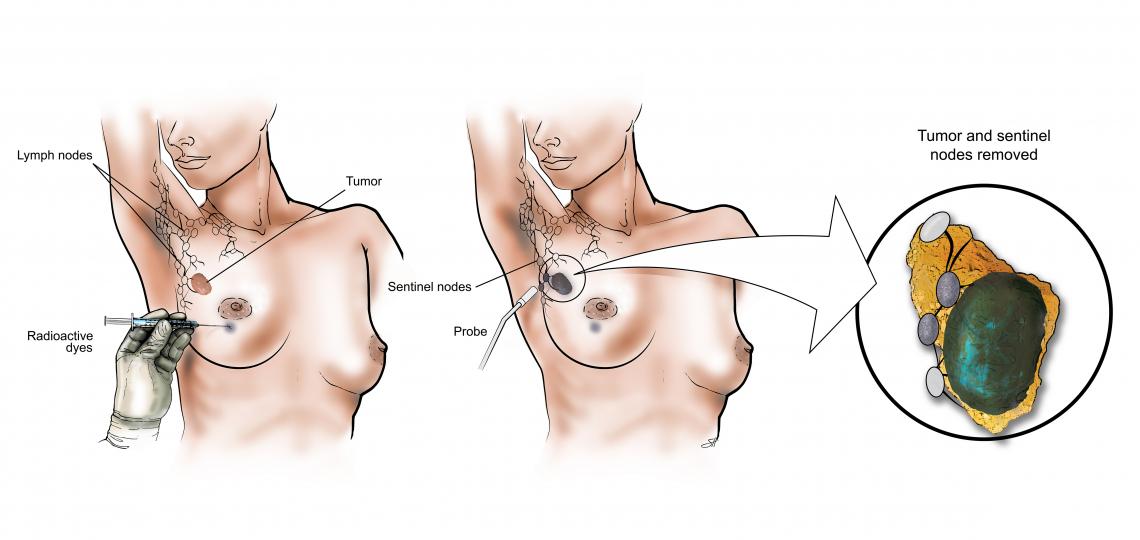Sentinel Lymph Node Biopsy
Dye is injected into the breast, one to four of the nodes is identified with a probe and removed to see if cancer cells are present.
What Are Lymph Nodes?
Lymph nodes are small organs, typically ranging from the size of a pea to a little bean, which are located throughout the body. Lymph nodes are one of the components of the lymphatic system. There are clusters of lymph nodes under the arm, in the groin, and in the neck.
The lymphatic system also includes a web of vessels that carry a fluid called lymph. Lymph is a colorless substance, which helps fight infections by clearing waste from the blood and keeping tissues clean and firm. If it spreads, breast cancer usually travels through the lymphatic system, and the lymph nodes are the first place it goes. Checking lymph nodes for cancer cells allows doctors to understand the behavior of the disease in the person's body and guide treatment decisions.
Our specialist breast surgical oncologists may remove one or more lymph nodes in your axilla (armpit) to see if breast cancer has spread to the lymph nodes through a procedure known as axillary lymph node surgery.
Three Types of Axillary (Armpit) Lymph Node Surgery
Each one of these operations aims to sample and/or remove the armpit lymph nodes where breast cancer may have spread. The type of procedure your surgeon will perform will depend on the likelihood of there being cancer in the nodes.
Sentinel Lymph Node Biopsy
A sentinel lymph node biopsy involves the removal of the “sentinel” or sentry lymph nodes guarding the breast. The sentinel lymph nodes are the first ones that the tumor cells may have spread to. During this procedure, before the actual operation begins, one or two “dyes” are injected into the breast and identify the first armpit lymph glands that cancer cells would travel to—the sentinel lymph nodes.
Through a small cut under the arm, one to four of the nodes identified by the dyes can be removed and sent to a lab for testing. The remaining lymph nodes are left untouched, and the incision is closed without needing a drain tube.
Axillary Lymph Node Dissection
During an axillary lymph node dissection, the contents of the armpit, including the lymph nodes, are removed through an incision under the arm. This operation is performed when one or more of the lymph nodes have been found to contain cancer. During the surgery, the cancer-containing nodes are removed while important nerves, blood vessels, and other internal structures of the armpit are preserved.
When the incision is closed, a drain tube is left in place and attached to a small plastic bottle to remove fluids that might otherwise collect in the armpit. The drain usually stays in place for about ten days. The bottle is emptied daily to record how much drains.
Targeted Axillary Dissection (TAD)
In a targeted axillary dissection (TAD), the surgeon will remove specific lymph nodes identified before treatment started that have been treated with drug therapy to see how the cancer is responding to that treatment. This is combined with the sentinel lymph node procedure described above and may need to go on to axillary lymph node dissection.
A targeted axillary node dissection is not possible for everyone but can reduce the amount of surgery needed in the armpit in appropriately selected women after chemotherapy.
What to Expect Before Your Lymph Node Surgery
When you have your initial surgical consultation, your doctor will give information about what to expect before and after the day of your procedure.
A week or two before the date of your operation, you will have an anesthetic assessment, where a nurse will do some blood tests along with other general health checks. It is also a chance for you to ask any questions you might have. Nothing is too small or unimportant to discuss. We want you to feel as comfortable as possible about the procedure.
In the time before surgery, it is recommended that if you are a smoker, you stop smoking. Smoking increases the chance of complications like infection after surgery. You will also receive instructions about what not to eat and drink on the day of your surgery since you will be under General Anesthesia.
References
Kwon, R. J. (2017). Sentinel Lymph Node Dissection versus Complete Axillary Dissection in Invasive Breast Cancer. Oxford Medicine Online. doi:10.1093/med/9780199384075.003.0022
Lymph Node Dissection: What to Expect. (n.d.). Retrieved May 21, 2019, from https://www.breastcancer.org/treatment/surgery/lymph_node_removal/dissection_expectations
Lymph Node Status and Staging. (n.d.). Retrieved May 21, 2019, from https://www.komen.org/breast-cancer/diagnosis/stages-staging/lymph-node-status/








 Credit
Credit
